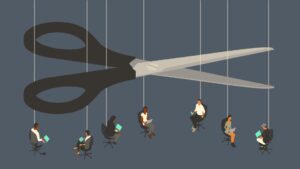Understanding the Current Wave of Layoffs in Corporate America
The landscape of corporate America is shifting dramatically, and the recent spate of layoffs has left many wondering: what’s really going on? At Extreme Investor Network, we delve deeper into these trends, offering insights that set us apart from the rest.
A Changing Economic Landscape
Recently, the economic environment has become turbulent, with businesses facing mounting pressure to cut costs in response to global uncertainties. While Elon Musk’s government cost-cutting initiative may have ended, its consequences linger. Companies are still grappling with the aftereffects of tariffs and trade tensions that have fueled discussions around pricing strategies and workforce reductions.
For many firms, layoffs are a primary strategy to rein in expenses. Despite a seemingly positive jobs report in April, private sector hiring, particularly in tech, hit its lowest point in over two years. This dichotomy illustrates the complex dynamics affecting employment today.
The AI Factor in Workforce Decisions
Artificial Intelligence (AI) is increasingly shaping hiring and headcount decisions. Leaders in the tech sector are communicating a clear trend: jobs are being incrementally replaced by AI solutions. Klarna’s CEO, Sebastian Siemiatkowski, noted that the fintech company has reduced its workforce by 40% due in part to investments in AI. Similarly, Shopify has mandated employees justify staffing needs when AI alternatives exist.
This move towards automation reflects a growing sentiment in the technology sector, where companies are not just addressing current economic pressures, but strategizing for future efficiency.
Key Layoff Announcements
Several notable corporations have recently announced significant workforce reductions:
Procter & Gamble
The consumer goods giant is set to cut 7,000 jobs, roughly 15% of its non-manufacturing workforce. The restructuring is part of a broader initiative to streamline its operations and enhance profitability.
Microsoft
The tech behemoth plans to lay off about 6,000 employees, accounting for 3% of its total workforce. This decision aims to reduce management layers, a strategic move to boost efficiency.
Citigroup
With plans to cut around 3,500 positions in China, Citigroup is undergoing a significant reorganization under CEO Jane Fraser. This is part of their broader strategy to enhance profitability after recent underperformance compared to peers.
Walmart
The retail giant is about to cut approximately 1,500 jobs across its global technology and operations divisions. Walmart’s massive employment footprint makes these cuts noteworthy as they reflect a shift in operational strategy amidst impending price hikes due to tariffs.
Klarna
Klarna’s drastic decision to reduce its global workforce by 10% follows substantial layoffs earlier in the year. The company’s pivot to AI solutions is driving their need to re-evaluate staffing levels.
CrowdStrike
The cybersecurity firm is also adjusting to market needs by cutting around 500 jobs. The CEO cited AI as a pivotal factor in reshaping their workforce needs.
Disney
Disney is set to lay off several hundred employees across various departments as part of an initiative to streamline operations. This move echoes the broader trend in the entertainment industry towards greater efficiency.
Chegg
Faced with competition from AI-driven educational tools, Chegg announced layoffs encompassing about 22% of its workforce. The CEO has highlighted an expected cost-saving of up to $110 million in the next year alone.
Amazon and Warner Bros. Discovery
Both companies are making minor cuts—Amazon around 100 jobs in its devices division and WBD laying off fewer than 100 employees—as part of broader organizational restructuring efforts.
The Bigger Picture
As we analyze these developments at Extreme Investor Network, it’s clear that the current wave of layoffs reflects a broader trend in corporate America—a shift towards automation and increased efficiency.
Understanding these dynamics not only allows investors to make informed decisions but also prepares employees and businesses to adapt to an evolving economic landscape. Stay with us for ongoing insights on how to navigate these changes and spot new opportunities in this rapidly shifting environment.

